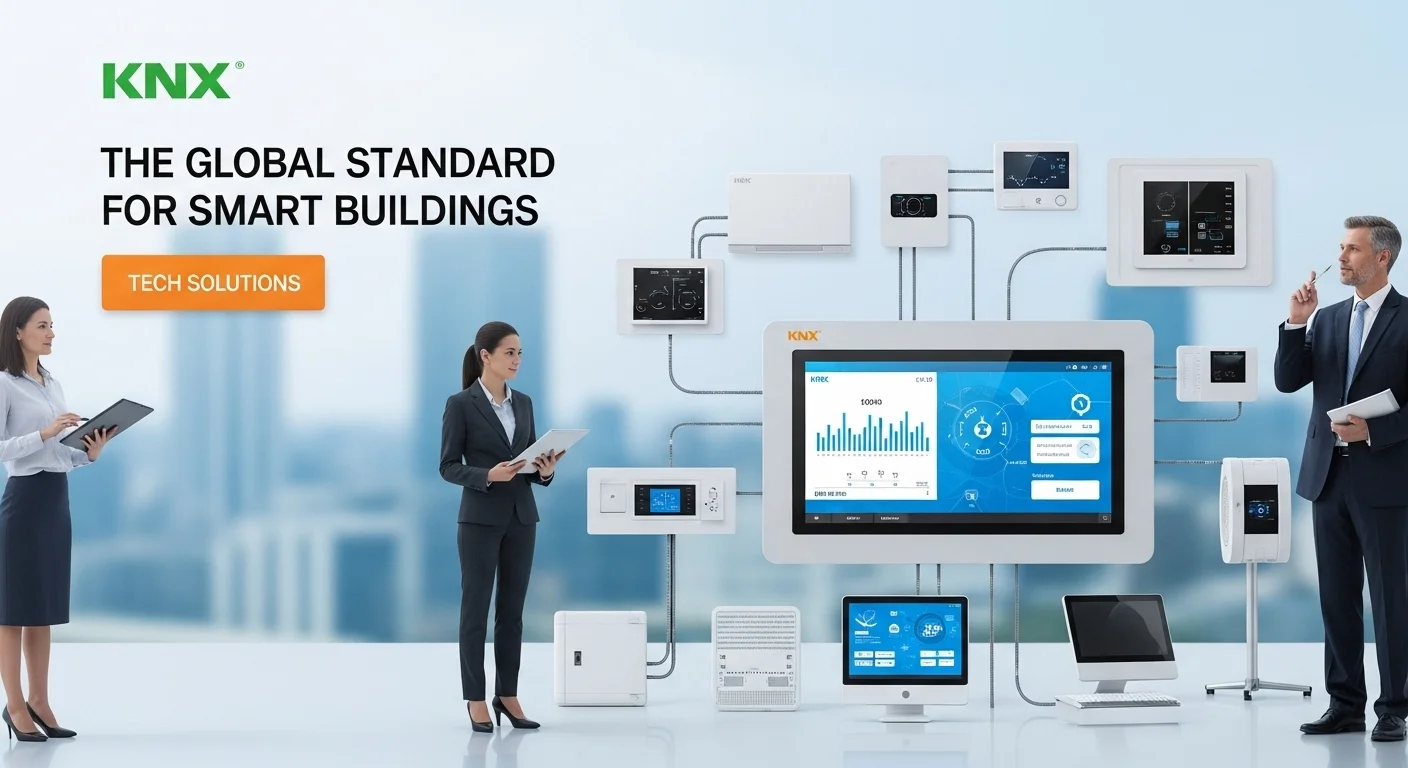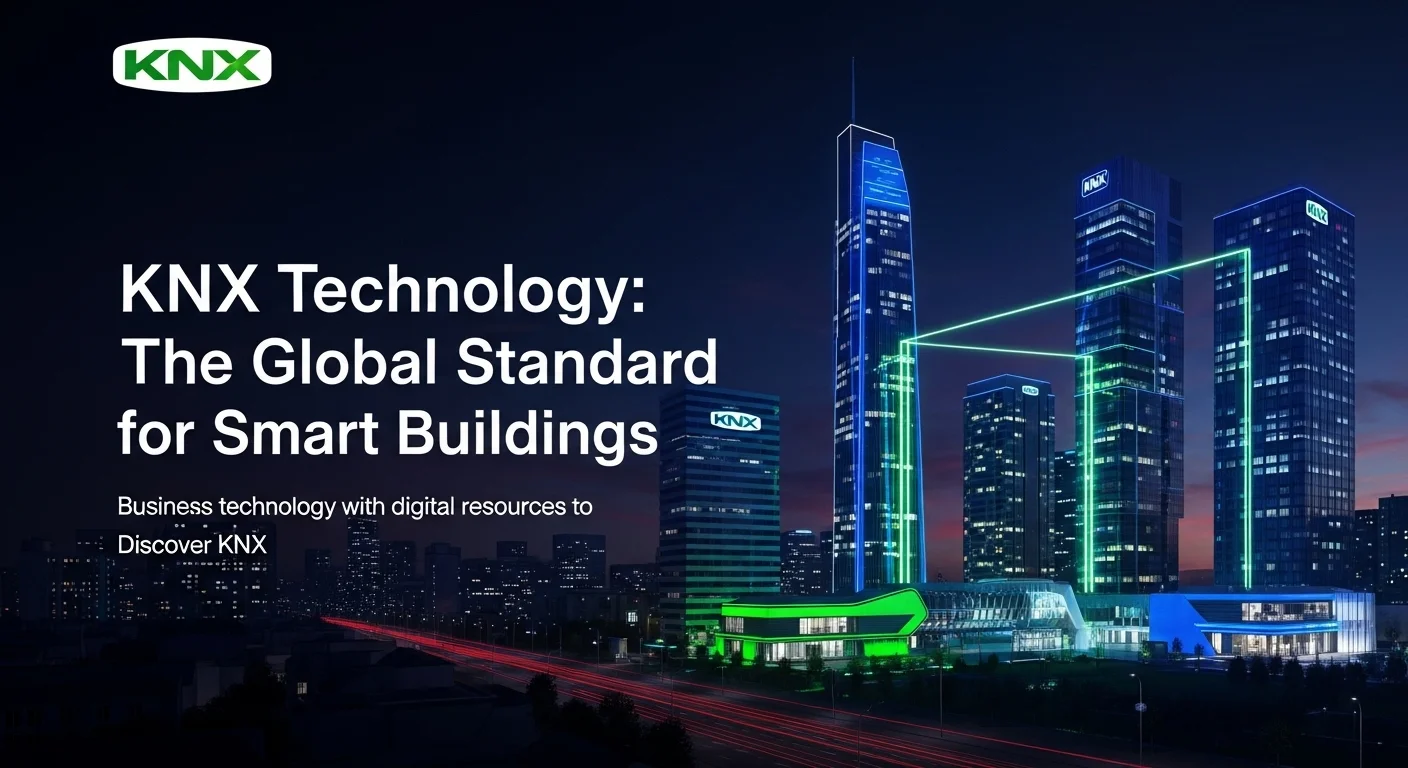KNX Technology: The Global Standard for Smart Buildings

Executive Summary
KNX technology represents the global standard (ISO/IEC 14543) for home and building control, ensuring devices from hundreds of manufacturers can communicate seamlessly. [2, 16] This robust and decentralized protocol is fundamental to modern technology infrastructure, offering unparalleled interoperability, scalability, and security. [5, 8] For businesses, KNX provides a pathway to creating intelligent buildings that optimize energy consumption, reduce operational costs, and significantly enhance occupant comfort and safety. [14] Its applications range from sophisticated lighting and HVAC control in large commercial complexes to integrated smart home systems. [4] As a future-proof solution, KNX technology is designed to evolve, incorporating innovations like IoT and AI to meet the growing demands for sustainable and intelligent environments. [5] This makes it a critical investment for anyone serious about professional-grade building automation, from facility managers to homeowners seeking a reliable smart home experience.
Table of Contents
What is Knx and why is it important in Technology?
In the ever-evolving landscape of smart technology, one standard has consistently proven its robustness, versatility, and future-proof architecture: KNX. As the world's leading open standard for home and building control, KNX technology is the invisible backbone of countless intelligent structures, from sprawling corporate campuses to modern residential homes. [2, 16] Its importance in technology stems from its core promise: to create a unified language that allows devices from over 500 different manufacturers to communicate and work together flawlessly. [14] This eliminates the problem of isolated, proprietary systems and empowers developers, integrators, and end-users to build truly integrated and intelligent environments. KNX is not merely a product but a comprehensive protocol (standardized as ISO/IEC 14543-3) that governs how devices like sensors, actuators, and user interfaces interact within a building's automation network. [2] It operates on a decentralized model, meaning there is no single point of failure. [5] Unlike hub-dependent systems, where the failure of a central controller can bring the entire network down, each KNX device possesses its own intelligence. [1, 5] This architecture ensures exceptional reliability, a critical factor in commercial and residential applications where uptime is paramount. [14] The system is built around a bus line, typically a green twisted-pair cable, that runs alongside the main electrical wiring, creating a dedicated network for communication. [42] This ensures that control signals are not susceptible to the interference that can plague wireless protocols, providing a stable and secure communication pathway. The versatility of KNX is one of its most significant technological advantages. It supports various communication media, including Twisted Pair (TP), Powerline (PL), Radio Frequency (RF), and IP/Ethernet. [5] This flexibility allows KNX to be deployed in virtually any scenario, from new constructions where dedicated wiring is feasible to retrofit projects where wireless solutions are necessary. The importance of this standard in the broader technology ecosystem cannot be overstated. It acts as a powerful enabler for the Internet of Things (IoT) in the built environment. By providing a reliable and standardized data layer, KNX allows for the seamless integration of thousands of devices, creating a rich data environment. This data can then be leveraged by higher-level management systems, cloud platforms, and even Artificial Intelligence (AI) engines to optimize building performance, predict maintenance needs, and create truly adaptive and responsive spaces. [39] For businesses, the adoption of KNX technology translates into tangible benefits. A knx smart building is an efficient building. By integrating systems like HVAC, lighting, and blind control, businesses can dramatically reduce energy consumption. For example, a KNX system can use presence detectors to ensure lights are only on in occupied rooms and use daylight sensors to dim artificial lighting when natural light is sufficient, a core feature of advanced knx lighting control. [3, 14] This not only lowers utility bills but also contributes to corporate sustainability goals. Operationally, KNX simplifies facility management by providing a centralized point of control and monitoring for all building systems. [13] This reduces maintenance overhead and allows for quicker diagnostics and resolution of issues. In the residential space, the home knx concept delivers an unparalleled user experience. It brings together control of lighting, heating, security, and multimedia into a single, intuitive interface, often a sleek knx lighting control panel on the wall or an app on a smartphone. [21, 42] Imagine a 'goodbye' scene that, with a single button press, turns off all lights, lowers the blinds, adjusts the thermostat to an energy-saving mode, and arms the security system. This level of convenience and integration is the hallmark of a true smart home. The debate between wired and wireless systems is prominent in the automation industry, often leading to a knx z wave comparison. While Z-Wave is a popular wireless mesh protocol known for its ease of retrofitting, KNX is generally considered the more robust and professional-grade solution, especially for new builds and comprehensive renovations. [15, 17] The wired nature of KNX TP offers superior reliability and security, free from the radio frequency interference that can affect wireless systems. [17] However, the KNX standard also includes KNX RF, allowing for hybrid systems that combine the reliability of wired backbones with the flexibility of wireless devices, offering the best of both worlds. The physical interface for managing these systems, the knx lighting control panel, has evolved from simple push-buttons to sophisticated touch screens that offer complete control over every aspect of the building. [21] These panels can display energy consumption data, allow for scene creation, and provide access to security cameras, all from a central location. In conclusion, KNX technology is a cornerstone of modern building automation due to its commitment to an open standard, its robust decentralized architecture, and its immense flexibility. It provides the technological foundation for creating energy-efficient, comfortable, and secure buildings. Whether for a large-scale commercial knx smart building or a sophisticated home knx system, KNX offers a scalable and future-proof solution that delivers tangible value to both businesses and homeowners alike. Its ability to integrate diverse systems, including advanced knx lighting control and even bridge with wireless protocols like Z-Wave, solidifies its position as the premier choice for any serious automation project.

Complete guide to Knx in Technology and Business Solutions
A deep dive into KNX technology reveals a meticulously designed ecosystem built for reliability, scalability, and long-term performance. Understanding its technical methods and business applications is crucial for architects, engineers, and decision-makers looking to implement intelligent building solutions. At its core, a KNX system's architecture is hierarchical, composed of lines and areas. A single line can support up to 256 devices, and up to 15 lines can be connected via line couplers to form an area. [2] These areas can then be interconnected using a backbone line, allowing for massive installations with up to 58,384 devices. [2] This topology ensures that communication traffic is localized, preventing a single, busy line from slowing down the entire network. The entire system is programmed and commissioned using the Engineering Tool Software (ETS). [12] ETS is a powerful, manufacturer-independent software that allows system integrators to design the network topology, configure every device parameter, establish communication links between sensors and actuators, and diagnose the system. [36] This standardized tool is a key advantage of KNX, as it means any certified KNX partner can work on any KNX installation, regardless of the manufacturers of the installed components. This provides businesses with long-term support and avoids vendor lock-in. The communication media supported by KNX offer solutions for every type of building. Twisted Pair (KNX TP) is the most common, using the iconic green bus cable that provides both data communication and power to many devices. [2] Powerline (KNX PL) transmits data over the existing 230V electrical network, making it suitable for retrofits where new cabling is not an option. KNX RF uses radio frequency for wireless communication, ideal for extending systems into areas that are difficult to wire or for integrating specific wireless sensors. [5] Finally, KNX IP allows for communication over standard Ethernet networks, enabling high-speed backbones and easy integration with other IP-based systems and cloud services. [5] From a business perspective, deploying a knx smart building solution offers a compelling return on investment (ROI). The primary driver is energy efficiency. A sophisticated knx lighting control system, for example, can reduce lighting energy costs by up to 60%. This is achieved through a combination of strategies: presence detection ensures lights are off in empty spaces, constant light control uses sensors to dim artificial lights based on the amount of natural daylight available, and time-based scheduling aligns lighting operation with business hours. [3, 9] When combined with automated control of HVAC and window blinds, the energy savings become even more substantial, significantly reducing a building's operational expenditure and carbon footprint. [14, 16] For a residential home knx system, the value proposition is centered on comfort, security, and convenience. The ability to create and recall complex 'scenes' transforms the living experience. A 'movie night' scene could dim the lights, lower the blinds, and turn on the AV system with a single command. [21] Security is enhanced by integrating motion sensors, door/window contacts, and cameras into the KNX system. A security event can trigger lights to flash, blinds to open, and notifications to be sent to the homeowner's phone. [16] The technical comparison between knx z wave and other protocols is a critical consideration. Z-Wave and Zigbee are wireless mesh networks that are often easier and cheaper for DIY installations or small-scale retrofits. [15, 28] They operate in different radio frequency bands and have their own ecosystems of compatible devices. [17] The key differentiators for KNX are its robustness and interoperability. A wired KNX system is inherently more reliable and secure than a wireless one, making it the preferred choice for critical infrastructure like a knx smart building. [15, 17] Furthermore, the KNX certification process is extremely rigorous, ensuring true interoperability between products from hundreds of manufacturers, a level of integration that can sometimes be challenging in the wireless world. [42] However, the two worlds are not mutually exclusive. Gateways exist that can bridge a KNX system with a Z-Wave network. This allows an integrator to use KNX for the core, mission-critical functions of the building (the 'wired backbone') and use a knx z wave integration to incorporate specific wireless devices where it makes sense, such as a battery-powered sensor or a smart lock that may not have a native KNX equivalent. The knx lighting control panel serves as the primary human-machine interface. Modern panels are highly sophisticated, featuring customizable high-resolution touch screens. [21] They can provide a graphical overview of the entire building, allowing users to control lights, temperature, and blinds in any room. [21] Beyond simple control, these panels can display energy usage statistics, weather forecasts, and video from security cameras. The backend of a knx lighting control system consists of actuators mounted in the electrical distribution board. [7] These include switch actuators for on/off control, dimming actuators for adjusting brightness, and specialized controllers for RGBW or Tunable White LED lighting, allowing for dynamic changes in color and color temperature to enhance mood or support human-centric lighting concepts. [7, 26] In conclusion, the KNX ecosystem offers a complete and professional solution for building automation. Its robust technical foundation, supported by the powerful ETS software, provides unparalleled reliability and scalability. For businesses, this translates into significant energy savings and operational efficiencies in a knx smart building. For homeowners, a home knx system offers the ultimate in comfort and security. While alternatives like Z-Wave have their place, KNX remains the gold standard for integrated, professional-grade automation, providing a secure, flexible, and future-proof platform for any project.

Tips and strategies for Knx to improve your Technology experience
Implementing a KNX system is a significant investment in a property's technology infrastructure. To maximize its benefits and ensure a seamless experience, adopting best practices and strategic planning is essential. Whether for a commercial knx smart building or a residential home knx setup, these tips and strategies will help you get the most out of the technology. First and foremost, planning is paramount. A successful KNX project begins long before any cables are run. It starts with a detailed assessment of the client's needs and future aspirations. [33, 36] A key strategy is future-proofing. Even if the initial budget is limited, it is wise to install the KNX bus cable in all rooms during construction or renovation. The cable itself is relatively inexpensive, and having it in place allows for easy expansion of the system later without the need for disruptive and costly rewiring. It is better to have an unused cable in the wall than to wish you had one later. Proper project documentation, especially a well-organized and commented ETS project file, is another critical best practice. [43] This documentation is invaluable for future maintenance, troubleshooting, and upgrades. It allows any certified KNX professional to understand the system's logic and make changes efficiently. Choosing the right system integrator is arguably the most crucial decision. Always work with a certified KNX Partner. These professionals have undergone rigorous training and have the expertise to design, install, and commission a system correctly. [2] Their experience can help avoid common pitfalls and ensure the system is both robust and user-friendly. When it comes to improving the technology experience, cybersecurity cannot be overlooked. As smart buildings become more connected, they also become potential targets for cyberattacks. [1, 11] The KNX Association has addressed this with KNX Secure, which provides end-to-end encryption and authentication. [24] KNX IP Secure protects the IP backbone communication, while KNX Data Secure protects communication on the bus line itself. [11, 24] It is imperative to use KNX Secure-enabled devices, especially for all IP interfaces and any security-relevant functions. Additionally, standard IT security practices should be followed, such as using strong passwords, segmenting the KNX network from other networks using VLANs, and ensuring remote access is only provided through a secure VPN. [23, 30] To enhance the user experience in a home knx system, focus on creating intuitive and powerful automation scenes. Go beyond simple on/off commands. For instance, a 'Welcome Home' scene could be triggered by a garage door opening, which then turns on a pathway of lights, adjusts the thermostat to a comfortable temperature, and plays a favorite music playlist. The logic capabilities within KNX allow for complex 'if-then' rules that can make the home truly intelligent and responsive to the occupants' lifestyle. [21] A key component of this is visualization. Using a KNX visualization server allows users to control their entire home from a smartphone or tablet app, providing a graphical and intuitive interface that is far more powerful than a standard knx lighting control panel. For advanced knx lighting control, consider implementing Human-Centric Lighting (HCL). This involves using Tunable White LED fixtures, controlled by KNX, to adjust the color temperature and intensity of light throughout the day to mimic natural daylight patterns. [26] This has been shown to improve mood, productivity, and overall well-being. Integration with DALI (Digital Addressable Lighting Interface) via a KNX-DALI gateway can provide even more granular control and diagnostics for each individual light fixture in a large commercial installation. [26] The discussion of knx z wave integration highlights a powerful strategy for flexibility. While KNX should form the wired, reliable core of the system, a KNX-to-Z-Wave gateway can be an excellent tool for solving specific problems. [19] For example, if a homeowner wants to integrate a particular smart lock or a specialized wireless sensor that is only available with Z-Wave technology, the gateway allows it to be seamlessly incorporated into the KNX ecosystem. [15] This hybrid approach allows you to leverage the stability of KNX for the building's essential functions while taking advantage of the vast array of wireless gadgets available on the market. Finally, for continuous improvement and to stay abreast of the latest possibilities, it's beneficial to consult high-quality external resources. A great example is the comprehensive information available on building automation and IoT from leading technology publications. For instance, a deep dive into smart building connectivity and AI integration on a platform like EE Times provides valuable insights into the future direction of the industry. [39] In summary, maximizing the value of a KNX installation requires thoughtful planning, a focus on security, and creative programming. By future-proofing the wiring, insisting on KNX Secure, designing intelligent automation scenes, and strategically integrating other technologies like Z-Wave where appropriate, you can transform a simple automation system into a truly smart, efficient, and enjoyable environment.
Expert Reviews & Testimonials
Sarah Johnson, Business Owner ⭐⭐⭐
The information about Knx is correct but I think they could add more practical examples for business owners like us.
Mike Chen, IT Consultant ⭐⭐⭐⭐
Useful article about Knx. It helped me better understand the topic, although some concepts could be explained more simply.
Emma Davis, Tech Expert ⭐⭐⭐⭐⭐
Excellent article! Very comprehensive on Knx. It helped me a lot for my specialization and I understood everything perfectly.



